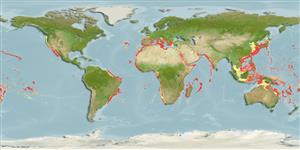Common names from other countries
Environment: milieu / climate zone / depth range / distribution range
Écologie
; profondeur 50 - 850 m (Ref. 881). Tropical; 46°N - 23°S, 119°E - 56°E
Indo-Pacific, Atlantic Ocean and the Mediterranean: from Taiwan to New Caledonia, north to Italy and east to Reunion Island. Tropical and subtropical.
Length at first maturity / Taille / Poids / Âge
Maturity: Lm 1.8 range ? - ? cm Max length : 3.4 cm CL mâle / non sexé; (Ref. 106434); 4 cm CL (female)
Maximum depth from Ref. 97531. Maximum length based on occurrence (Ref. 106434); to be replaced with a better reference. Occurs in the continental shelf (Ref. 122888) and bathyal communities of the upper and middle slope (Refs. 113874, 102666), where it is dominant in the latter (Ref. 102666). Found in muddy and rocky bathyal substrates (Ref. 122889).
Life cycle and mating behavior
Maturité | Reproduction | Frai | Œufs | Fécondité | Larves
Members of the order Decapoda are mostly gonochoric. Mating behavior: Precopulatory courtship ritual is common (through olfactory and tactile cues); usually indirect sperm transfer.
Pinho, M.R., J.M. Gonçalves, H.R. Martins and G.M. Menezes. 2001. (Ref. 2747)
Statut dans la liste rouge de l'IUCN (Ref. 130435)
statut CITES (Ref. 108899)
Not Evaluated
Not Evaluated
Utilisations par l'homme
Pêcheries: commercial
| FishSource |
Outils
Sources Internet
Estimates based on models
Preferred temperature
(Ref.
115969): 8.8 - 21.2, mean 14.2 (based on 536 cells).
Résilience
Haut, temps minimum de doublement de population inférieur à 15 mois (K=0.65-0.84; tm=1.5).
